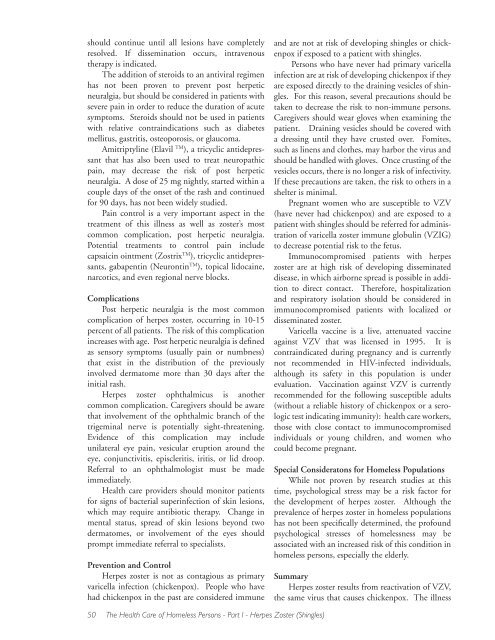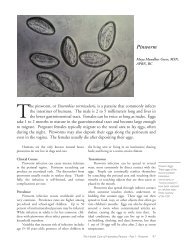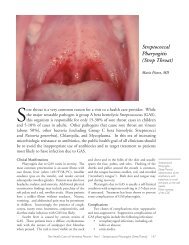Herpes Zoster (Shingles) - Boston Health Care for the Homeless
Herpes Zoster (Shingles) - Boston Health Care for the Homeless
Herpes Zoster (Shingles) - Boston Health Care for the Homeless
You also want an ePaper? Increase the reach of your titles
YUMPU automatically turns print PDFs into web optimized ePapers that Google loves.
should continue until all lesions have completely<br />
resolved. If dissemination occurs, intravenous<br />
<strong>the</strong>rapy is indicated.<br />
The addition of steroids to an antiviral regimen<br />
has not been proven to prevent post herpetic<br />
neuralgia, but should be considered in patients with<br />
severe pain in order to reduce <strong>the</strong> duration of acute<br />
symptoms. Steroids should not be used in patients<br />
with relative contraindications such as diabetes<br />
mellitus, gastritis, osteoporosis, or glaucoma.<br />
Amitriptyline (Elavil TM ), a tricyclic antidepressant<br />
that has also been used to treat neuropathic<br />
pain, may decrease <strong>the</strong> risk of post herpetic<br />
neuralgia. A dose of 25 mg nightly, started within a<br />
couple days of <strong>the</strong> onset of <strong>the</strong> rash and continued<br />
<strong>for</strong> 90 days, has not been widely studied.<br />
Pain control is a very important aspect in <strong>the</strong><br />
treatment of this illness as well as zoster’s most<br />
common complication, post herpetic neuralgia.<br />
Potential treatments to control pain include<br />
capsaicin ointment (Zostrix TM ), tricyclic antidepressants,<br />
gabapentin (Neurontin TM ), topical lidocaine,<br />
narcotics, and even regional nerve blocks.<br />
Complications<br />
Post herpetic neuralgia is <strong>the</strong> most common<br />
complication of herpes zoster, occurring in 10-15<br />
percent of all patients. The risk of this complication<br />
increases with age. Post herpetic neuralgia is defined<br />
as sensory symptoms (usually pain or numbness)<br />
that exist in <strong>the</strong> distribution of <strong>the</strong> previously<br />
involved dermatome more than 30 days after <strong>the</strong><br />
initial rash.<br />
<strong>Herpes</strong> zoster ophthalmicus is ano<strong>the</strong>r<br />
common complication. <strong>Care</strong>givers should be aware<br />
that involvement of <strong>the</strong> ophthalmic branch of <strong>the</strong><br />
trigeminal nerve is potentially sight-threatening.<br />
Evidence of this complication may include<br />
unilateral eye pain, vesicular eruption around <strong>the</strong><br />
eye, conjunctivitis, episcleritis, iritis, or lid droop.<br />
Referral to an ophthalmologist must be made<br />
immediately.<br />
<strong>Health</strong> care providers should monitor patients<br />
<strong>for</strong> signs of bacterial superinfection of skin lesions,<br />
which may require antibiotic <strong>the</strong>rapy. Change in<br />
mental status, spread of skin lesions beyond two<br />
dermatomes, or involvement of <strong>the</strong> eyes should<br />
prompt immediate referral to specialists.<br />
Prevention and Control<br />
<strong>Herpes</strong> zoster is not as contagious as primary<br />
varicella infection (chickenpox). People who have<br />
had chickenpox in <strong>the</strong> past are considered immune<br />
and are not at risk of developing shingles or chickenpox<br />
if exposed to a patient with shingles.<br />
Persons who have never had primary varicella<br />
infection are at risk of developing chickenpox if <strong>the</strong>y<br />
are exposed directly to <strong>the</strong> draining vesicles of shingles.<br />
For this reason, several precautions should be<br />
taken to decrease <strong>the</strong> risk to non-immune persons.<br />
<strong>Care</strong>givers should wear gloves when examining <strong>the</strong><br />
patient. Draining vesicles should be covered with<br />
a dressing until <strong>the</strong>y have crusted over. Fomites,<br />
such as linens and clo<strong>the</strong>s, may harbor <strong>the</strong> virus and<br />
should be handled with gloves. Once crusting of <strong>the</strong><br />
vesicles occurs, <strong>the</strong>re is no longer a risk of infectivity.<br />
If <strong>the</strong>se precautions are taken, <strong>the</strong> risk to o<strong>the</strong>rs in a<br />
shelter is minimal.<br />
Pregnant women who are susceptible to VZV<br />
(have never had chickenpox) and are exposed to a<br />
patient with shingles should be referred <strong>for</strong> administration<br />
of varicella zoster immune globulin (VZIG)<br />
to decrease potential risk to <strong>the</strong> fetus.<br />
Immunocompromised patients with herpes<br />
zoster are at high risk of developing disseminated<br />
disease, in which airborne spread is possible in addition<br />
to direct contact. There<strong>for</strong>e, hospitalization<br />
and respiratory isolation should be considered in<br />
immunocompromised patients with localized or<br />
disseminated zoster.<br />
Varicella vaccine is a live, attenuated vaccine<br />
against VZV that was licensed in 1995. It is<br />
contraindicated during pregnancy and is currently<br />
not recommended in HIV-infected individuals,<br />
although its safety in this population is under<br />
evaluation. Vaccination against VZV is currently<br />
recommended <strong>for</strong> <strong>the</strong> following susceptible adults<br />
(without a reliable history of chickenpox or a serologic<br />
test indicating immunity): health care workers,<br />
those with close contact to immunocompromised<br />
individuals or young children, and women who<br />
could become pregnant.<br />
Special Consideratons <strong>for</strong> <strong>Homeless</strong> Populations<br />
While not proven by research studies at this<br />
time, psychological stress may be a risk factor <strong>for</strong><br />
<strong>the</strong> development of herpes zoster. Although <strong>the</strong><br />
prevalence of herpes zoster in homeless populations<br />
has not been specifically determined, <strong>the</strong> profound<br />
psychological stresses of homelessness may be<br />
associated with an increased risk of this condition in<br />
homeless persons, especially <strong>the</strong> elderly.<br />
Summary<br />
<strong>Herpes</strong> zoster results from reactivation of VZV,<br />
<strong>the</strong> same virus that causes chickenpox. The illness<br />
50 The <strong>Health</strong> <strong>Care</strong> of <strong>Homeless</strong> Persons - Part I - <strong>Herpes</strong> <strong>Zoster</strong> (<strong>Shingles</strong>)







